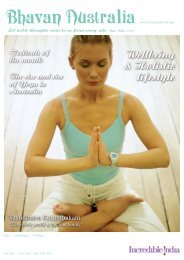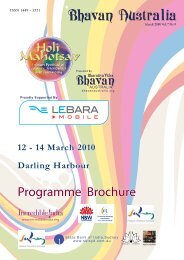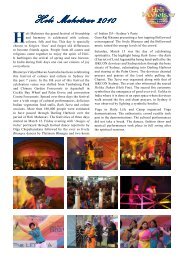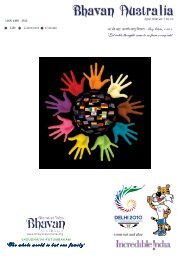World Peace - Bharatiya Vidya Bhavan Australia
World Peace - Bharatiya Vidya Bhavan Australia
World Peace - Bharatiya Vidya Bhavan Australia
Create successful ePaper yourself
Turn your PDF publications into a flip-book with our unique Google optimized e-Paper software.
4. Mumukshatva—purification of the soul by rigorous<br />
cultivation of the will to attain the realization<br />
of ultimate Truth.<br />
After these four stages are passed there is a final<br />
stage consisting of 3 substages: Shravana, manana,<br />
and nididhyasana.<br />
Shravana—learning the Truth from the Master.<br />
Manana—practice this teaching by full concentration.<br />
Nididhyasana—ceaseless meditation on the Truth,<br />
which leads to the realization of aspirant’s identity<br />
with the Brahman, which is pure Consciousness.<br />
According to Sankara, a Jivanmukta is in the body not<br />
of the body. He is free to meditate, or aimlessly go<br />
about the world or engage himself in doing good to<br />
others, serving the poor, preaching to people.<br />
Regarding Maya or illusion Sankara’s approach has<br />
often been misunderstood or misinterpreted. The<br />
rope perceived as snake demonstrates his concept<br />
of illusion. The rope is a Vyavaharika Sattva while<br />
the perceived snake a Pratibhasika Sattva. In the<br />
dark a rope is perceived as a snake and the moment<br />
light is on, this illusory perception is seen correctly<br />
as merely a rope. Therefore, Sankara’s enunciation<br />
of illusion is related to perception of the ultimate<br />
Truth of Brahman or Pure Consciousness as the<br />
only reality and our identification with our bodies<br />
are essentially illusory. The body and all other living<br />
& non-living matter are but organic in nature and<br />
that which pervades all this matter is the Brahman<br />
without which they cannot exist. These are manifestations<br />
or super-impositions of the supreme Brahman.<br />
The objects of such perceptions are known as<br />
anirvachaniya, that is they neither exist (sat) nor<br />
44 | <strong>Bhavan</strong> <strong>Australia</strong> | August 2012<br />
are non-existent (asat). The Brahman only is.<br />
The Brahma Sutra (Section two Sutra 1 & 2) says:<br />
Sarvatra Prasiddopadeshat Janmadyasya yatah.<br />
Everything comes from Brahman, sustained by Brahman,<br />
and goes back to Brahman. Sankara in his commentary<br />
refers to a couple of verses from the<br />
Chandokya Upanishad (III 14.1-2). The verses state:<br />
“All this is Brahman. Everything comes from Brahman,<br />
everything goes back to Brahman, and everything<br />
is sustained by Brahman”. Each person has a<br />
mind of his own. What a person wills in his present<br />
life, he becomes when he leaves this world. The<br />
whole world is his creation. He is everywhere in the<br />
world. He has no sense organs, and he is free from desire.<br />
His self is spotless and pure. He has a subtle<br />
body which is prana.<br />
The Third verse explains: Brahman is both within the<br />
heart and smaller than a barley seed as well as outside<br />
the body and greater than all the three worlds<br />
(earth inter-space and heaven).<br />
We can go on and on like this since the Upanishads,<br />
the Sutras, the Vedas and other Vedic Texts offer us<br />
diverse views and insights into the Universal Truth.<br />
But ultimately all these boil down to this question.<br />
How as an individual, one attains enlightenment? As<br />
we have already said, there are many views and<br />
hence many paths to Redemption. The path we<br />
choose depends upon our level of evolution or understanding<br />
of life. The simplest and best way is to surrender<br />
to a chosen Deity and go about one’s duties,<br />
leaving the rest to Him. To a more inquiring mind, the<br />
path of Reason, or Jnana can be suggested. Hence we<br />
arrive at the Truth by sheer reasoning. Let us see<br />
how: While human beings are also organisms, they<br />
are organisms with a difference. They have the mind<br />
and intellect, which helps to differentiate between<br />
points of view. Some basic principles of life therefore<br />
become evident. These are the laws of Causation and<br />
Transmigration of souls. These can also be derived<br />
from the Third law of Sir Isaac Newton (action and reaction<br />
are equal and opposite) and Einstein’s Theory<br />
of Relativity with its equation e = mc2 (energy equals<br />
mass times the square of the speed of light).<br />
Cause and effect are easily understood. Say, you are<br />
angry with your wife? Why? Because she put more<br />
salt in the curry! Or anything like this. Without a<br />
cause there cannot be an effect. That is why it is said,<br />
good begets good and evil begets evil. How does this<br />
affect the human condition? All our actions have to<br />
produce reactions. Then we have to experience the<br />
effects of the reaction and start another action. Action<br />
is implied in the human life. Since we have to experience<br />
the results of our action, be it good or bad,









